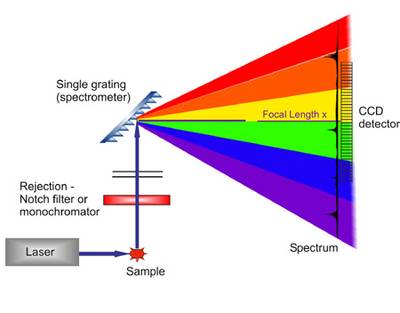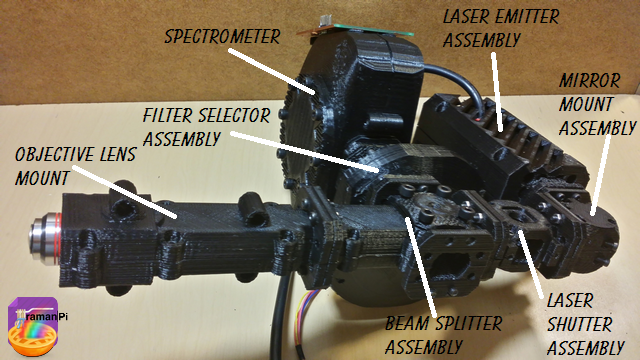
Schematic of a Dispersive Raman Single Spectrometer (image source: Horiba)
Hackers, designers, and engineers have a positive outlet in the Hackaday Prize Competition, a hardware design competition acknowledging the benefits of free and open sharing of intuitive and useful technology. 2014 saw some very tough competition, and one Hackaday award in particular stands out for 3D printing enthusiasts. The ramanPi is a Raman spectrometer project winning Fifth Prize in the competition, and it is notable for its use of 3D printing in its components. What exactly is a spectrometer and how is 3D printing involved here?
Spectrometers are instruments that measure electromagnetic light. Typically used to identify materials, they have only been affordable for large labs (they can cost tens of thousands of dollars) until now–with the help of 3D printable components. The public’s lack of access to these important scientific instruments has been unfortunate, since they help detect the makeup of substances and have widespread applicability. For example, they can help identify impurities in water.
The expenses associated with these devices are changing, thanks, in part, to 3D printing. The ramanPi is a 3D printed Raman Spectrometer built around a Raspberry Pi–which is a cheap and very small computer– using 3D printed and off-the-shelf parts. This is an important project because of what devices like this can reveal about our material environment. But what does “Raman” refer to? Raman refers to the way light scatters. Most photons scatter elastically from an atom or molecule (called “Rayleigh scattering”), leaving the scattered photons with the same wavelengths and frequencies as the original photons. Excitation causes about 1 in 10 million to scatter non-elastically, and this is referred to as “Raman scattering.”
A Raman spectrometer measures this scattering, and these measurements are very significant in the examination of a material’s structural properties. Since Raman bands directly result from molecular vibrations, they allow for the study of subtle differences–and this is what makes them so unique and important. This is valuable in any industry setting, such as pharmacology, mineralogy, and the study of biological systems, where analysis of materials’ structural properties matter.

image source: Hackaday
The ramanPi has many other advantages, including: more than just chemical information about materials is made available; it’s easy to work with samples; you can analyze samples in water; it can be used with almost any material, except pure metals; it can connect to multiple internet databases; it can fit almost any budget; and many of its components can be used for outside purposes.
It is precisely the design’s 3D printable components that make it so affordable, bringing complex scientific research and analytic tools that much closer to classrooms and small scale lab environments. According to the ramanPi creator, fl@C@:
“The design can be reproduced very easily. For high volume production you could use injection molding to make the 3D parts. 3D printing for lower quantities would be a totally acceptable option…The optical assembly and 3D parts are the showcase of this system in respect to ingenuity and innovation. This is a one of a kind system and the only DIY raman spectrometer design available, let alone open source.”

The full system with spectrometer printed on a daVinci 1.0 3D printer (image source: Hackaday)
With the invention of the ramanPi, the 3D printing revolution just got more exciting, helping shine more light on the smallest details of our world. These are details that many more of us may soon be able to understand with the help of this very useful device. Check out this video explaining the spectrometer in more detail:
Subscribe to Our Email Newsletter
Stay up-to-date on all the latest news from the 3D printing industry and receive information and offers from third party vendors.
You May Also Like
3D Printing Webinar and Event Roundup: May 5, 2024
We’ve got a busy week of 3D printing events ahead of us, in Texas, Florida, Washington, D.C., Shanghai, and more. Webinar offerings will cover medical models, PolyJet 3D printing, additive...
High Stakes, High Speed: KVG Acquires 15 Nexa3D HSE 3D Printers to Boost Military Tech
As 3D printing increasingly intersects with defense and military logistics, a new partnership between Nexa3D and mission support logistics firm KVG stresses the growing importance of this technology in strategic...
Construction 3D Printing CEO Reflects on Being Female in Construction
Natalie Wadley, CEO of ChangeMaker3D, could hear the words of her daughter sitting next to her resounding in her head. “Mum, MUM, you’ve won!” Wadley had just won the prestigious...
3D Printing News Briefs, February 17, 2024: Shot Blasting, Service Bureaus, & More
In today’s 3D Printing News Briefs, we’re starting out with post-processing, as SKZ Würzburg is using a shot blast system from AM Solutions for its research. Moving on to business,...































